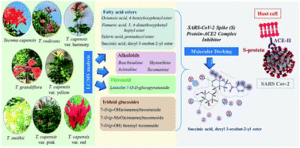We are very pleased to introduce Professor Usama Ramadan Abdelmohsen and Dr Amira R. Khattab, corresponding authors of the paper ‘In silico identification of SARS-CoV-2 spike (S) protein–ACE2 complex inhibitors from eight Tecoma species and cultivars analyzed by LC-MS‘. Their article has been very well received and handpicked by our reviewers and handling editors as one of our November HOT articles. Usama and Amira told us more about the work that went into this article and what they hope to achieve in the future. You can find out more about the authors and their article below and find more HOT articles in our online collection.
Meet the authors
 Usama Ramadan Abdelmohsen received his B.Sc. in Pharmaceutical Sciences from Minia University, Egypt in 2002. He received his Ph.D. with an Egyptian fellowship award from the University of Würzburg, Germany, with his thesis entitled ‘Antimicrobial activities from plant cell cultures and marine sponge-associated actinomycetes’ under the guidance of Professor Ute Hentschel. His academic interests are the isolation and structure elucidation of anti-infective secondary metabolites from marine sources in particular sponge-associated actinomycetes using spectroscopic, genomic, and metabolomic tools to discover new natural products.
Usama Ramadan Abdelmohsen received his B.Sc. in Pharmaceutical Sciences from Minia University, Egypt in 2002. He received his Ph.D. with an Egyptian fellowship award from the University of Würzburg, Germany, with his thesis entitled ‘Antimicrobial activities from plant cell cultures and marine sponge-associated actinomycetes’ under the guidance of Professor Ute Hentschel. His academic interests are the isolation and structure elucidation of anti-infective secondary metabolites from marine sources in particular sponge-associated actinomycetes using spectroscopic, genomic, and metabolomic tools to discover new natural products.
Dr. Amira R. Khattab is an associate professor of natural product chemistry, and currently serving as Vice-Dean of Student Affairs and Quality at College of Pharmacy, Arab Academy for Science, Technology & Maritime Transport. Dr. Khattab is a graduate of the Faculty of Pharmacy, Alexandria University, Egypt (2005). She received her MSc degree from Alexandria University, Egypt (2011) and her PhD from Tanta University, Egypt (2015) in natural product chemistry. Her main research interest is the metabolome analysis of phytopharmaceuticals and functional foods aided by modern bioinformatics tools for authentication and quality control.
Could you briefly explain the focus of your article to the non-specialist (in one or two sentences only) and why it is of current interest?
Our article has shed the light on the renaissance of the prophylactic potential of natural products against the COVID-19. This is of current interest as SARS-CoV-2 has raised a great public health emergency and that evoked an urgency for developing effective anti-SARS-CoV-2 therapeutics.
How big an impact could your results potentially have?
In fact, the proposed drug candidates possess an in silico inhibitory action towards SARS-CoV entry machinery to the host cells which makes them promising drug leads for the prophylaxis against COVID-19.
Could you explain the motivation behind this study?
Our motivation behind the study is to hopefully aid in the faster development of phytotherapeutics with an added-preventive potential that might help in halting the spread of COVID-19 and in better management of the fatal disease.
In your opinion, what are the key design considerations for your study?
Actually, our main concern in designing the research work plan was to properly inspect and select the phytochemicals that can possibly disrupt binding hotspots at the surface of the receptor-binding domain (RBD) of the viral spike protein when complexed with hACE2.
Which part of the work towards this paper proved to be most challenging?
The most challenging part of this work was finding phytoligands that could fit the middle shallow pit of the surface of the receptor-binding domain (RBD) of spike protein SARS-CoV-Spike-ACE2 complex, with low affinity for ACE2.
What aspect of your work are you most excited about at the moment?
Surprisingly, we managed to identify one of the Tecoma phytoligands namely succinic acid, decyl-3-oxobut-2-yl ester as being the most promising one because of its comparable binding affinity to hesperidin, which is the only compound reported till now that could target the binding interface between spike protein and e human angiotensin converting enzyme “hACE2”.
What is the next step? What work is planned?
Nature has endowed us with many privileged scaffolds possessing a wide pharmacological spectrum. Hence, we are planning to continue exploring the potential inhibitory action of naturally occurring compounds towards the viral entry machinery through destabilizing the functional SARS-CoV-Spike-ACE2 complex, other than inhibiting hACE2 without having any appreciable affinity for binding to ACE2 due to its well-proven in vivo pulmonary protective role in acute lung injury.
In silico identification of SARS-CoV-2 spike (S) protein–ACE2 complex inhibitors from eight Tecoma species and cultivars analyzed by LC-MS
Seham S. El Hawary, Amira R. Khattab, Hanan S. Marzouk, Amira S. El Senousy, Mariam G. A. Alex, Omar M. Aly, Mohamed Teleb and Usama Ramadan Abdelmohsen
RSC Adv., 2020,10, 43103-43108
DOI: 10.1039/D0RA08997D, Paper
 Submit to RSC Advances today! Check out our author guidelines for information on our article types or find out more about the advantages of publishing in a Royal Society of Chemistry journal.
Submit to RSC Advances today! Check out our author guidelines for information on our article types or find out more about the advantages of publishing in a Royal Society of Chemistry journal.
Keep up to date with our latest HOT articles, Reviews, Collections & more by following us on Twitter. You can also keep informed by signing up to our E-Alerts.












